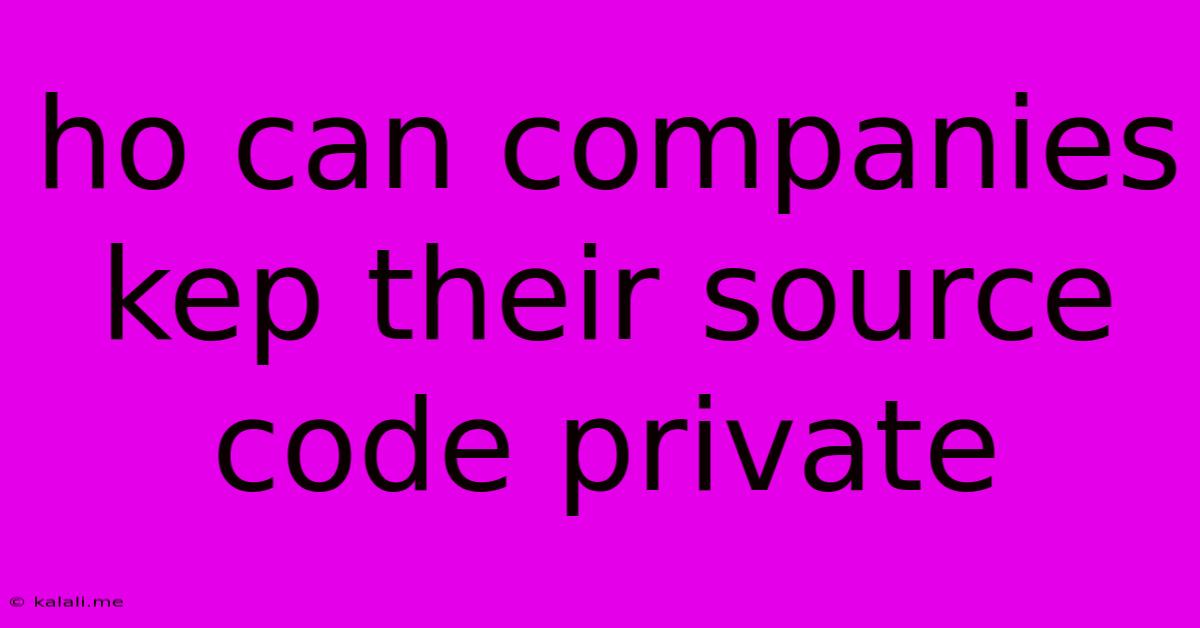Ho Can Companies Kep Their Source Code Private
Kalali
Jun 02, 2025 · 3 min read

Table of Contents
How Can Companies Keep Their Source Code Private? Protecting Your Intellectual Property in the Digital Age
Protecting your company's source code is paramount. It's the lifeblood of your software, containing valuable intellectual property (IP) and trade secrets that give you a competitive edge. A leak can lead to devastating financial losses, reputational damage, and even legal battles. This article delves into the multifaceted strategies companies can employ to safeguard their source code.
Meta Description: Learn effective strategies to keep your company's source code private, including secure coding practices, access control, robust security infrastructure, and legal protection. Protect your valuable intellectual property today.
Secure Coding Practices: The Foundation of Source Code Protection
Before even considering external security measures, implementing secure coding practices is fundamental. This isn't just about avoiding vulnerabilities; it's about building security into the very fabric of your code.
- Regular Security Audits and Penetration Testing: Employ rigorous code reviews and penetration testing to proactively identify and mitigate vulnerabilities. Think of this as a preventative health checkup for your software.
- Input Validation and Sanitization: Never trust user input. Always validate and sanitize all data entering your system to prevent injection attacks (SQL injection, cross-site scripting, etc.).
- Secure Libraries and Frameworks: Use well-maintained, reputable libraries and frameworks that are regularly updated with security patches. Outdated components are prime targets for attackers.
- Principle of Least Privilege: Grant users only the necessary access to specific parts of the codebase. This limits the potential damage if a breach occurs.
- Secure Configuration Management: Ensure your servers and development environments are properly configured with strong passwords, up-to-date security patches, and firewalls.
Access Control and Management: Limiting Exposure
Restricting access to your source code is crucial. This involves careful management of user permissions and robust authentication mechanisms.
- Version Control with Access Restrictions: Utilize version control systems like Git, but implement granular permissions to control who can view, edit, and commit code. Consider using private repositories hosted on secure platforms.
- Role-Based Access Control (RBAC): Implement RBAC to assign permissions based on job roles. Different team members should have different levels of access based on their responsibilities.
- Two-Factor Authentication (2FA): Require 2FA for all developers and personnel with access to the source code. This adds an extra layer of security against unauthorized access.
- Regular Audits of User Access: Periodically review and audit user access rights to ensure they are still appropriate and revoke any unnecessary privileges.
Robust Security Infrastructure: Protecting Your Environment
Your entire infrastructure needs to be fortified to protect your source code.
- Secure Development Environments: Establish secure development environments that are isolated from production systems. This minimizes the risk of compromising your live application.
- Network Security: Implement strong firewalls, intrusion detection systems (IDS), and intrusion prevention systems (IPS) to protect your network from external threats.
- Data Encryption: Encrypt your source code both at rest and in transit. This makes it much harder for attackers to access even if they manage to breach your systems.
- Regular Security Updates and Patching: Stay up-to-date with the latest security patches for all your software and hardware. Vulnerable systems are easy targets.
Legal Protections: Safeguarding Your Rights
Legal measures are an essential part of protecting your source code.
- Non-Disclosure Agreements (NDAs): Require all employees, contractors, and third-party vendors who access your source code to sign NDAs.
- Copyright Protection: Register your source code with the appropriate copyright authorities. This provides legal recourse if your code is stolen.
- Patent Protection: If your source code incorporates novel inventions, consider seeking patent protection.
Conclusion: A Multi-Layered Approach to Source Code Protection
Protecting your source code is a continuous process, requiring a multi-layered approach combining secure coding practices, robust access control, a fortified security infrastructure, and strong legal protections. By prioritizing these strategies, companies can significantly reduce the risk of source code leaks and protect their valuable intellectual property.
Latest Posts
Latest Posts
-
How To Find Barried Sprinkler Line
Jun 04, 2025
-
Why Are Bottle Caps The Currency In Fallout
Jun 04, 2025
-
Why Is The Wicked Witch Of The West Green
Jun 04, 2025
-
How To Wire Two 12volt Batteries To Make 24
Jun 04, 2025
-
What Do You Call The Written Style Of A Foreignlanguage
Jun 04, 2025
Related Post
Thank you for visiting our website which covers about Ho Can Companies Kep Their Source Code Private . We hope the information provided has been useful to you. Feel free to contact us if you have any questions or need further assistance. See you next time and don't miss to bookmark.